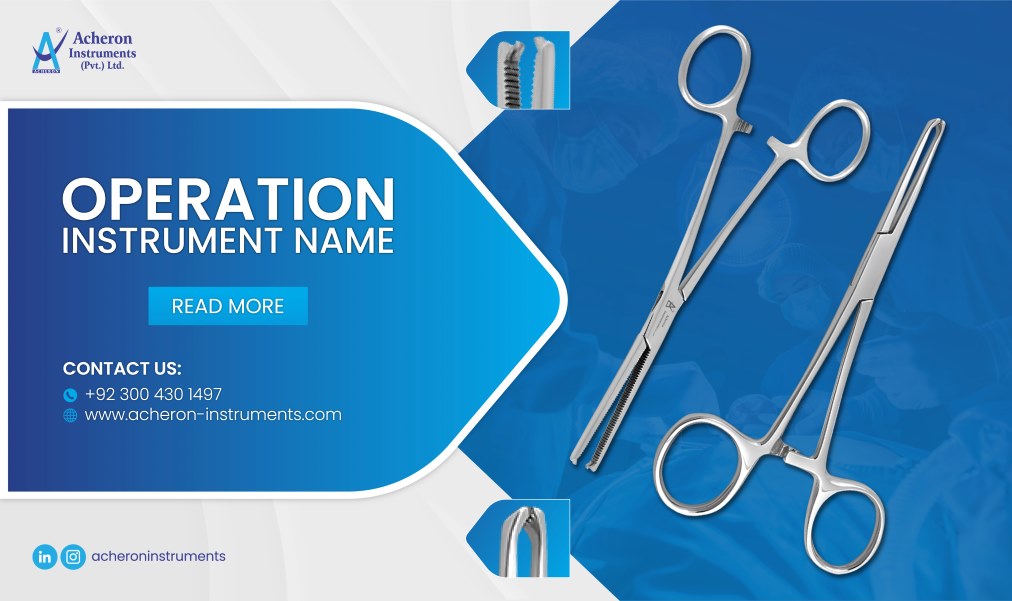
In the realm of surgical instruments, there are certain tools that look similar but serve different purposes. Two of the most important forceps used widely during ENT surgeries are Luc's forceps and tonsil-holding forceps. There is often confusion regarding the two of them because they look alike in their design but they have distinctive characteristics. In this blog, we will be doing a comprehensive understanding of both these forceps including their features, design, and functionality. Apart from this, we will also delve into Lucs forceps vs tonsil holding forceps to know their differences that will help you choose the right equipment for your next surgical practice.
Understanding Lucs forceps
Luc’s forceps is one of the versatile tools used by otolaryngologists that assist healthcare professionals in grasping and removing foreign particles or small tissue fragments from nasal passages. This instrument is greatly useful during ethmoidectomy and other sinus procedures. This incredible tool was developed by a French otolaryngologist named Emile Luc and is aimed at helping doctors treat various diseases in the nasal sinuses.
Sinus surgeries are usually recommended by doctors when the infection keeps on spreading without any response to the drugs. Moreover, surgeons usually use this tool for removing nasal tumors and polyps during endoscopic sinus surgeries. Also, these forceps are known for delicate handling and precision, making them an ideal choice for delicate surgeries where fine control is important.
Features of Lucs forceps
- Finger ring handles with long frames that enhance control, dexterity, and grip
- Wide finger rings reduce hand strain and increase comfort during lengthy procedures
- Oval fenestrated jaws are helpful during ethmoid sinuses to remove bones or soft tissues from the area
- Blunt the outer surface of the jaws to prevent damage to the surrounding structures
- Enhances visibility in confined spaces with the straight neck of the jaws
- Features a slender profile to access the deeper regions of the nose
- The angled design between the shaft and the handle facilitates clear visibility of the jaws
- Multiple patterns available for surgical convenience and approach for every patient
Understanding Tonsil holding forceps
Denis Browne tonsil holding forceps are one of the most essential equipment used during tonsillectomy procedures. Surgeons use this tool to hold and mobilize the tonsillar tissues before separating them from the underlying fossae during dissection.
This amazing tool provides a firm grip and control over the tonsillar tissues when doctors decide to remove these tonsils due to breathing issues or neck pain. Moreover, these forceps come in different sizes and designs to suit different surgical needs. Also, these forceps facilitate surgical maneuvers during delicate tonsillectomy procedures.
Features of tonsil holding forceps
- Facilitates surgeons for adequate dissection by moving tonsil tissues away from their bed
- Comprises large finger ring handles to enhance dexterity and reduce finger strain
- Features an elongated design to reach deep surgical areas in the neck region
- Holds tonsillar tissues with a firm grip due to oval fenestrated jaws
- Enables enhanced accessibility to the lateral pharyngeal planes due to curved shafts
- Allows stable and adequate tractions with its fenestrated jaws having a blunt outline
Difference between Lucs forceps vs tonsil holding forceps
Both Lucs and tonsil-holding forceps have so many characteristics in common. But despite multiple similarities, here are a few dissimilarities that make them different from each other:
Tips design:
The major difference between these two forceps lies in the design of their tips. By having a closer look at the tonsil holding forceps, you will observe that these forceps comprise smooth edges of the tips because their job is just to hold the tonsil tissue. On the other hand, Luc’s forceps feature sharper edges of the tips as surgeons also use them further for some cutting.
Cup-shaped tips
Both forceps come with a cup-shaped tip design. However, in the context of tonsil-holding forceps, the cup-shaped tip of the upper arm is designed to fit into the tip of the lower arm.
Basic aim
Tonsil-holding forceps are specifically designed to hold and grasp tonsillar tissues and cannot be used for any other surgical procedure. Whereas, Luc’s forceps are versatile instruments that are used to grasp nasal tissues and other foreign objects in the nasal passages. Luc’s forceps are generally not preferable for tonsillectomy procedures.
Variations
Luc’s forceps come in multiple variations including the choice between fenestrated or non-fenestrated cup-shaped jaws. On the other hand, tonsil-holding forceps come in multiple size variations with only fenestrated cup-shaped jaws.
Lucs forceps vs tonsil holding forceps, which one to choose?
The choice between Luc's forceps vs Tonsil holding forceps depends on the specific surgical requirement at hand. There is no comparison between the two as both play crucial roles in ENT procedures. However, surgeons must choose the right equipment for their surgical practice to achieve optimal outcomes with precision and efficiency.
Conclusion
Luc's forceps and tonsil holding forceps are integral parts of ENT surgical practices and must be a part of every operating room toolkit for their incredible benefits. Not only do these amazing tools assist surgeons in performing their surgery with greater precision and efficiency but also contribute to the advancement of medical care as well as patient well-being.
Before choosing any surgical instrument among these two, it’s essential to consider their features, design, and compatibility as per your surgical requirements.
Looking for high-quality surgical forceps?
Investing in high-quality surgical instruments is beneficial as they not only enhance maximum performance but also last in your operating rooms for longer durations.
If you are looking for high-quality surgical forceps, you need to visit our wide range of surgical instruments. Acheron Instruments offers high-quality surgical instruments made with high-grade German stainless steel material that makes our tools robust, highly durable, and reliable. Moreover, we offer a diverse range of surgical forceps including hemostatic forceps, artery forceps, locking forceps, dissecting forceps, sponge-holding forceps, etc. and so many more.
All you need is to explore our diverse range of surgical forceps as well as other surgical instruments. Or, contact us on the contact number or email given on our website for further guidance. So, what are you waiting for? Place your orders now and that too at the most reasonable prices. We promise you won’t be disappointed!








